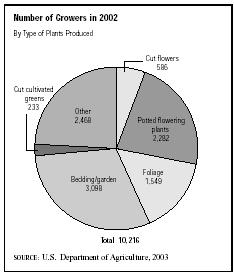SIC 0181
ORNAMENTAL FLORICULTURE AND NURSERY PRODUCTS
This category includes establishments primarily engaged in the production of ornamental plants and other nursery products, such as bedding plants, bulbs, florists' greens, flowers, shrubbery, potted plants, flower and vegetable seeds and plants, and sod. These products may be grown outdoors, or under cover of a greenhouse, frame, cloth house, or lath house.
NAICS Code(s)
111422 (Floriculture Production)
111421 (Nursery and Tree Production)
The floriculture market increased by 2 percent in 2002, after having slowly but steadily climbed throughout the decade from $2.5 billion in 1990 to $3.9 billion in 1998. The wholesale value of floriculture crops was estimated at $4.88 billion in 2002. The leading floriculture crop producer, California, accounted for $962 million of this total, while Florida accounted for $877 million. Combined, the two states produce 38 percent of U.S. floriculture. The total number of growers declined 8 percent in 2002 to 10,216.
With a wholesale value of $2.28 billion, bedding and garden plants account for 49 percent of floriculture crops. Between 2001 and 2002, the value of bedding and garden plants rose 5 percent, accounting for the majority of industry growth. The wholesale value of foliage plant crops grew 2 percent to $663 million in 2002, while the value of cut flower crops dropped 2 percent to $410 million, reaching its lowest point since 1986. This segment of the industry suffered in part due to increased foreign competition. The value of potted flowering plants remained steady at $822 million.
California, Florida, Texas, Michigan, and Ohio were the top producers of bedding plants. They accounted for 42 percent of the 2002 value of floriculture crops. Bedding plants included impatiens, petunias, geraniums (the 2002 top-seller), marigolds, pansies, and more. Begonias, zinnias, salvia, gerbera, dusty miller, snapdragons, alyssum, and coleus also had a healthy share of the market.
Also in 2002, according to the USDA, the amount of covered area in floriculture crop production was 911 million square feet, down from 1.07 billion square feet in 1997. Greenhouse space was 531 million square feet of this covered area, while film plastic structures were 368 million square feet. Shade and temporary cover accounted for 380 million square feet of covered area, the remaining area being rigid plastic or glass greenhouse area.
Operations increased the use of hired workers in 2002. Overall, 79 percent used hired workers in 2002, compared with 78 percent in 2001. On average growers used 15.3 hired workers per operation in 2002.
The cut-flower industry continued to suffer from foreign competition, particularly from warmer climates where growers do not need to heat greenhouses and labor is less expensive. After declining steadily in the late 1990s, the cut-flower industry was down another 2 percent

in 2002. The number of cut flower growers fell 6 percent to 586 in 2002. California produces roughly 68 percent of all U.S. cut flowers. Imports account for approximately 60 percent of cut flowers sold in the United States, with the top import countries being Colombia, Ecuador, and the Netherlands.
The month of May, which includes Mother's Day, accounts for approximately 11 percent of florists' annual sales. According to industry statistics, the personal consumer breakdown of floriculture was as follows: outdoor bedding/garden plants, 49 percent; cut flowers, 28 percent; flowering/green houseplants, 23 percent.
Industry leaders include Hines Horticulture, Inc., with 2002 sales of $336 million; The Scotts Company, with 2003 sales of $1.9 billion; and privately owned Color Spot Nurseries. The mega-company Monsanto, with 2003 sales topping $3.3 billion was also a major player, as well as being in a variety of other related feed and seed agricultural businesses. Other industry leaders included Ohio-based Yoder Brothers Inc., Idaho-based Rogers Seed Company, and California-based Monrovia Nursery Company.
Further Reading
National Agricultural Statistics Service. Floriculture Crops, 2002 Summary. Washington, DC: April 2003. Available from http://usda.mannlilb.cornell.edu/reports/nassr/other/zfc-bb/floran03.txt .
Society of American Florists. About Flowers, 2003. Available from http://www.aboutflowers.com .
U.S. Department of Agriculture. Ornamental Crops Market Reports, 2003. Available from http://www.ams.usda.gov/fv/mncs/orntren2.htm .
Comment about this article, ask questions, or add new information about this topic: